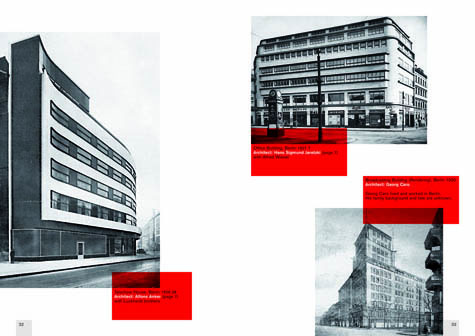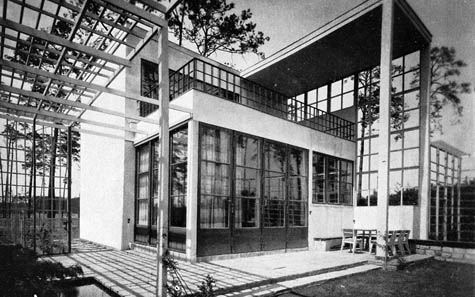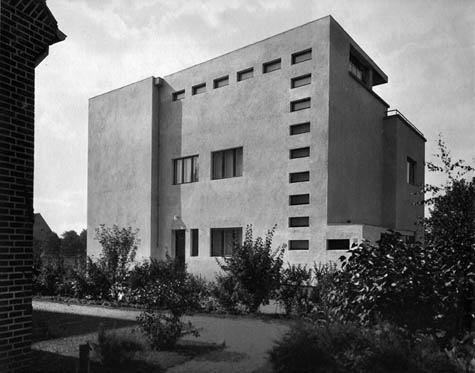 [Image: A spread from Pentagram Papers 37: Forgotten Architects].
[Image: A spread from Pentagram Papers 37: Forgotten Architects].Earlier this month, Pentagram released a pamphlet called Pentagram Papers 37: Forgotten Architects.
- In the 1920s and early 1930s, German Jewish architects created some of the greatest modern buildings in Germany, mainly in the capital Berlin. A law issued by the newly elected German National Socialist Government in 1933 banned all of them from practicing architecture in Germany. In the years after 1933, many of them managed to emigrate, while many others were deported or killed under Hitler’s regime. Pentagram Papers 37: Forgotten Architects is a survey of 43 of these architects and their groundbreaking work.

 [Image: Spreads from Pentagram Papers 37: Forgotten Architects].
[Image: Spreads from Pentagram Papers 37: Forgotten Architects].As Warhaftig wrote in an introduction to the project:
- On 1 November 1933, a few months after the German National Socialist Government came to power, a decree was issued banning Jewish architects from the Reichskulturkammer für bildende Künste, the state-governed association of fine art to which membership was required to practice architecture. Their academic titles were revoked and they were denied the use of the professional title "architect." Just short of two years later, on 15 September 1935, another law was adopted, further excluding from the association all so-called Half-Jews and those who were married to Jews. In total, nearly 500 architects were affected by the ban and forced to leave Germany. Those who stayed had to go into hiding or were deported to ghettos or concentration camps.
 [Image: A spread from Pentagram Papers 37: Forgotten Architects].
[Image: A spread from Pentagram Papers 37: Forgotten Architects].She continues:
- After long and circuitous routes, I have succeeded in locating relatives of the deceased architects. Scattered across all continents, they were able to offer additional authentic material. These historical documents and biographies, as well as photographs of the architects' buildings, are published for the first time in my book German Jewish Architects Before and After 1933: The Lexicon.
Indeed, it's impossible to look at today's European landscape in general and not spot absences, or losses, voids here and there punctuating the 21st century town and city.
 [Image: Tietz Department Store in Solingen (1930?), designed by Georg Falck; photo via Archive Dr. Hagspiegel].
[Image: Tietz Department Store in Solingen (1930?), designed by Georg Falck; photo via Archive Dr. Hagspiegel].The images here show some of the buildings that Myra Warhaftig's research, performed up until her death only three weeks ago, uncovered. Many more shots are available on Pentagram's project website.





 [Images: Showcase House, Werkbundsiedlung Breslow, by Moritz Hadda (1929); Terraced Houses, Berlin, by Alfons Anker (1929-30); Arnold Zweig Residence (1929-30), Eisner Residence (1927), and Schulze Residence (1928-29), all in Berlin and all magnificent designs by architect Harry Rosenthal; and a police station in Berlin by Richard Scheibner (1930-31)].
[Images: Showcase House, Werkbundsiedlung Breslow, by Moritz Hadda (1929); Terraced Houses, Berlin, by Alfons Anker (1929-30); Arnold Zweig Residence (1929-30), Eisner Residence (1927), and Schulze Residence (1928-29), all in Berlin and all magnificent designs by architect Harry Rosenthal; and a police station in Berlin by Richard Scheibner (1930-31)].Referring to the architects whose work is featured in the above seven photographs:
In 1933, Georg Falck fled with his family to the Netherlands: "In Amsterdam they survived in hiding until the end of the war. Falck died in a New York Hospital in May 1947, just six weeks after he and his family had emigrated to the USA."
Alfons Anker's business partners joined the Nazi party in 1933; six years later, he "managed to flee to Sweden, but never succeeded in re-establishing his career as an architect. Anker died in Stockholm in 1958."
Harry Rosenthal, architect of three houses featured above, "was born in Posen (today Poznan, Poland) in 1892. He lived and worked in Berlin where he ran a successful architectural practice. In 1933 he managed to flee to Palestine, but suffered from the subtropical climate. In 1938 he emigrated to England, where despite numerous attempts, he did not manage to re-establish his architectural career. He died in London in 1966."
In 1941, Moritz Hadda "was deported to an unknown location."
Richard Scheibner's "fate is unknown."
(Thanks to Michael Bierut and Kurt Koepfle at Pentagram for sending the booklet and spreads).
No comments:
Post a Comment